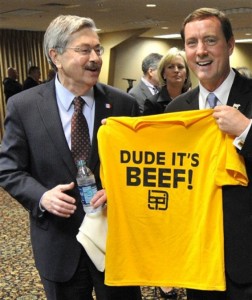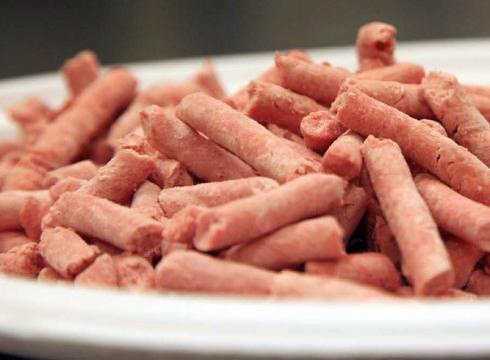Before I go any further, I want to make it clear that, as far as I”m concerned, there is not a single part of an animal”s body, or a product that comes from an animal”s body, that is appropriate for human consumption, whether or not the body parts in question are contaminated with pathogens. Using animals for our pleasure is wrong, and that remains true whether or not it is also physically harmful to us.
Having said that, I believe this story shines a light on some little-known facts about the products of animal slavery that many people, sadly, still consider ”food”. Unfortunately, the deceptively mild headline in The Times could almost be ignored by many as yet another report on yet another way that eating meat can kill you. Behind it, however, lies information that every person should know.
The ingredient in question is ammoniated beef trimmings (or ”pink slime”, as described by one USDA official). Ammoniated beef trimmings are a slaughterhouse product made from trimmings that were previously considered waste (or should I say, only considered suitable for ”pet food”). These trimmings “typically include most of the material from the outer surfaces of the carcass” which contains “larger microbiological populations”.
As stated in The Times, eight years ago, a company called Beef Products Inc. (BPI) came up with a way to turn the trimmings into money (to the tune of around $440 million a year), by turning them into “a mashlike substance frozen into blocks or chips”, that can be added to regular ground beef. The school lunch program, for instance, uses the processed beef because it saves them about $1 million a year.
As described in Grist.org,
“Evidently, scraps of cow flesh, swept up from slaughterhouse floors and pulverized into a kind of paste, are moving through the tubes… [and are] subjected to lashings of ammonium hydroxide to kill bacteria… The scene ends with heavily protected workers carefully packing uniform flesh-colored blocks into boxes.”
That”s right ” scraps of cow flesh swept up from slaughterhouse floors, pulverized and treated with ammonia are being sold as a food ingredient.
The fact that ammonia is generally considered a poison didn’t seem to bother the USDA, which not only approved the process, but also agreed to the company’s request that the ammonia be classified as a “processing agent” and not an ingredient that would have to be listed on labels.
“Officials at the USDA endorsed the company’s ammonia treatment, and have said it destroys E. coli ”to an undetectable level.” They decided it was so effective that in 2007, when the department began routine testing of meat used in hamburger sold to the general public, they exempted Beef Products.”
When the department began routine testing they exempted BPI. And since the processed beef was believed to be pathogen-free, it was also excluded from recalls, even when it was an ingredient in hamburgers found to be contaminated.
But tests done by the school lunch program have found both E. coli and salmonella in the ammoniated beef dozens of times. This could be due to the fact that, when treated with sufficient ammonia to kill the pathogens, the product was inedible, since it stunk of ammonia. The company”s response? They lessened the amount of ammonia used in the treatment, allowing the pathogens to survive, and potentially make their way into the digestive tracts of children and adults all over the US.
“Since 2005, E. coli has been found 3 times and salmonella 48 times, including back-to-back incidents in August in which two 27,000-pound batches were found to be contaminated. The meat was caught before reaching lunch-room trays.”
According to The Times, the majority of hamburger now sold in the U.S. contains fatty slaughterhouse trimmings which “the industry once relegated to pet food and cooking oil”.
“With the U.S.D.A.’s stamp of approval, the company’s processed beef has become a mainstay in America’s hamburgers. McDonald’s, Burger King and other fast-food giants use it as a component in ground beef, as do grocery chains. The federal school lunch program used an estimated 5.5 million pounds of the processed beef last year alone.”
Despite (or perhaps because of) the increased frequency of E. coli outbreaks in recent years, we seem to have all but forgotten what the name itself actually means, equating the name “E. coli” with simply, “food poisoning”. But we should never forget what E. coli actually is, since its origin serves to remind us of something very important about our food, namely, that what we call ”meat” is actually the flesh of an animal who has been killed, an animal with organs and bodily functions, similar to our own.
E. coli (or Escherichia coli) is a bacteria that lives in the bowels of animals that humans eat, and although most people don’t usually think about it (or perhaps even know about it), there”s a disturbing reason that it shows up in the food supply so frequently.
During slaughterhouse ”processing”, it”s fairly common that an animal”s bowels are ruptured, and when that happens, the contents spill out onto the flesh that will eventually end up on someone”s plate. The massive consumer demand for animal flesh results in US slaughterhouses killing and dismembering animals at a rate of over 300 per second. Considering those numbers, it”s almost impossible to avoid these kinds of incidents.
I know it”s graphic and disturbing, but to me, the fact that most people don”t even think about it is even more disturbing. Everybody should know the truth about what or whom they eat, about the products they generate demand for, and about the ethical practices of the companies they support with their purchases.
We shouldn”t fool ourselves into imagining that the meat industry cares about our safety, or the safety of our children. It would be foolish to expect them to act in an ethically sound manner, since they exist only to make a profit, and the product they provide is ethically deplorable from the outset.
They are making money by taking others” lives” Don”t expect them to be concerned about yours.






